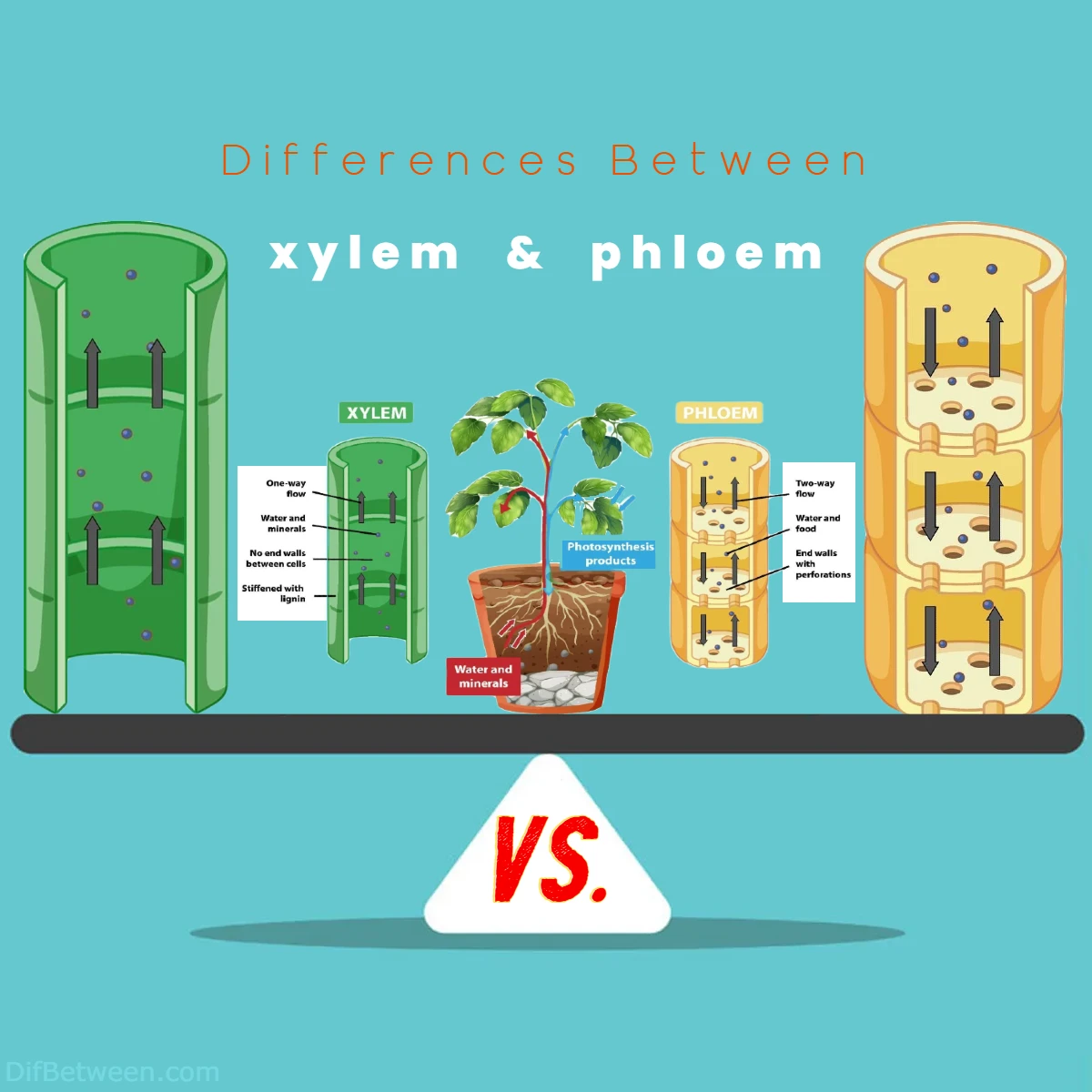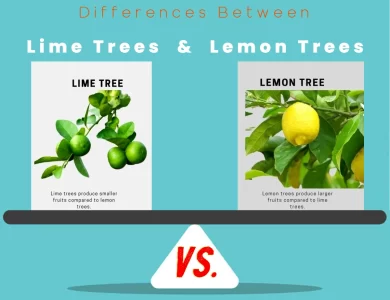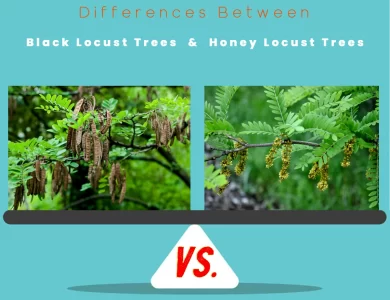
| Aspect | Xylem | Phloem |
|---|---|---|
| Function | Water and mineral transport | Nutrient (sugar) transport |
| Primary Cells | Tracheids, vessel elements, fibers, parenchyma cells | Sieve tube elements, companion cells, phloem fibers, phloem parenchyma cells |
| Transport Direction | Unidirectional (roots to shoots) | Bidirectional (source to sink and vice versa) |
| Transport Mechanism | Passive transport (cohesion, adhesion, tension) | Active transport (pressure flow hypothesis) |
| Substances Transported | Water, minerals | Sugars, organic compounds |
| Cell Communication | Minimal intercellular communication | Extensive intercellular communication via plasmodesmata |
| Structural Characteristics | Thick-walled cells for mechanical support | Thin-walled cells for efficient transport |
| Response to Environmental Factors | Influenced by water availability and gravity | Responsive to growth patterns and nutrient demand |
| Development | Differentiation in primary and secondary xylem | Differentiation in primary and secondary phloem |
| Relationship with Other Plant Parts | Connected to roots for water uptake | Collaborates with leaves for nutrient distribution |
| Adaptations for Survival | Structures to prevent air embolisms | Defenses against pests affecting nutrient flow |
| Evolutionary Significance | Evolution of lignified cells to support vertical growth | Enabled efficient allocation of resources for growth |
| Interplay and Balance | Provides pressure for nutrient transport | Provides energy for water transport |
| Evolutionary History | Ancient adaptation for terrestrial life | Evolved with complex plant body plans |
| Role in Plant Growth | Provides hydration and minerals | Supports growth through nutrient distribution |
Imagine the plant world as a bustling metropolis, where essential resources and nutrients flow like traffic along distinct routes. Just as a city’s infrastructure is diverse and purpose-driven, so too are these incredible vascular tissues.
Differences Between Xylem and Phloem
The main differences between xylem and phloem lie in their functions and structures within plants. Xylem primarily transports water and minerals from roots to aerial parts, utilizing capillary action and transpiration pull mechanisms. Structurally, xylem consists of tracheids, vessels, parenchyma, and fibers. In contrast, phloem serves as a conduit for transporting sugars, amino acids, and nutrients from source to sink, driven by the pressure flow hypothesis. Phloem is composed of sieve tubes, companion cells, parenchyma, and fibers. These distinct roles and components make xylem and phloem integral to the survival and growth of plants, showcasing the remarkable complexity of nature’s botanical highways.
Structure and Composition
Xylem: Plumbing the Depths
The xylem is the plant’s water and mineral highway, responsible for transporting water and nutrients from the roots to the rest of the plant. Its structure consists of four main cell types: tracheids, vessel elements, fibers, and parenchyma cells. These cells work in harmony to form a complex network that efficiently moves fluids.
- Tracheids: These elongated cells are the primary water-conducting elements in most plants. They have tapered ends with pits that allow water to flow between adjacent cells.
- Vessel Elements: Exclusive to angiosperms (flowering plants), vessel elements are wider and shorter than tracheids. They are stacked end-to-end to create vessels that resemble microscopic pipelines for fluid transport.
- Fibers: Providing structural support, fibers are long, slender cells with thick walls. They contribute to the overall mechanical strength of the xylem.
- Parenchyma Cells: These versatile cells are involved in storage and secretion. While not directly engaged in water transport, they play a role in maintaining the overall health of the xylem.
Phloem: The Sweet Passage
In contrast, the phloem takes charge of transporting the products of photosynthesis, such as sugars and organic molecules, from the leaves to other parts of the plant. It consists of four primary cell types: sieve tube elements, companion cells, phloem fibers, and phloem parenchyma cells. Together, these cells form a conduit for the movement of nutrients.
- Sieve Tube Elements: These are the main functional cells responsible for transporting sugars and other organic compounds. They form long tubes, and their end walls contain sieve plates with perforations, allowing for intercellular flow.
- Companion Cells: Working in partnership with sieve tube elements, companion cells support their metabolic functions. They are connected to sieve tube elements via plasmodesmata, microscopic channels that facilitate communication and nutrient exchange.
- Phloem Fibers: Just like in the xylem, phloem fibers provide structural support. However, in the phloem, they also assist in maintaining the tube’s integrity.
- Phloem Parenchyma Cells: Similar to their counterparts in the xylem, these parenchyma cells play a role in storage and support.
Transport Mechanisms
Xylem: Water’s Upward Journey
The primary role of xylem is to transport water and minerals acquired from the soil to various parts of the plant. This journey, often referred to as “transpiration stream,” relies on cohesion, adhesion, and tension.
Cohesion: Water molecules have a unique ability to stick to each other due to hydrogen bonding. This cohesion allows water to form a continuous column within the xylem vessels.
Adhesion: Water molecules also adhere to the walls of the xylem vessels. This adhesive property, combined with cohesion, helps counteract the force of gravity, enabling water to move upward.
Tension: As water evaporates from the stomata in leaves (a process known as transpiration), it creates a negative pressure or tension in the xylem. This tension pulls more water from the roots, maintaining a constant flow.
The table below summarizes the key features of xylem:
| Xylem | Function | Cell Types | Transported Substances |
|---|---|---|---|
| Water and mineral transport | Tracheids, vessel elements, fibers, parenchyma cells | Water, minerals |
Phloem: Nutrient Highway
Phloem, on the other hand, facilitates the movement of nutrients produced in the leaves through a process called “translocation.” Unlike the passive movement in xylem, translocation in phloem requires energy because it involves transporting solutes against their concentration gradient.
Pressure Flow Hypothesis: The widely accepted explanation for translocation in phloem is the pressure flow hypothesis. This hypothesis suggests that sugars produced in photosynthesizing cells create a high concentration in the source (usually leaves). This high concentration causes water to move into the phloem by osmosis, creating pressure. This pressure pushes the nutrient-rich sap toward areas of lower concentration, known as sinks, where the sugars are utilized for growth, storage, or other metabolic processes.
The table below provides an overview of the key features of phloem:
| Phloem | Function | Cell Types | Transported Substances |
|---|---|---|---|
| Nutrient (sugar) transport | Sieve tube elements, companion cells, phloem fibers, phloem parenchyma cells | Sugars, organic compounds |
Direction of Flow
Xylem: One-Way Street
The movement of water and minerals in the xylem is primarily unidirectional, flowing from the roots to the shoots. This flow is crucial for maintaining the plant’s water balance, providing hydration to all its parts.
Phloem: Bidirectional Route
In contrast, the flow of nutrients through the phloem is bidirectional. While the main direction is from source to sink (usually from leaves to growing regions or storage organs), phloem can also transport substances in the opposite direction when needed. This bidirectional flow allows for flexibility in distributing nutrients based on the plant’s requirements.
Response to Environmental Factors
Xylem: Battling Gravity and Drought
The xylem’s transport of water is greatly influenced by environmental factors, including gravity and water availability. During dry conditions, plants employ various strategies to minimize water loss and maintain the integrity of the transpiration stream. Stomata close to reduce transpiration, and in some cases, plants can even adjust the size of their tracheids and vessel elements to control water flow.
Phloem: Adjusting to Growth
Phloem transport is responsive to the plant’s growth patterns. For example, during periods of active growth, such as the growing season, the phloem’s transport capacity is enhanced to meet the increased demand for nutrients in rapidly dividing cells. In woody plants, the formation of new layers of phloem, known as the vascular cambium, contributes to the plant’s outward growth.
Development and Differentiation
Xylem: Building Strong Foundations
The development of xylem begins in the plant’s embryonic stages, with differentiation occurring in the vascular cambium and the procambium of the apical meristem. The primary xylem is formed early in a plant’s growth and is responsible for initial water and nutrient transport. As the plant matures, secondary xylem, also known as wood, is produced in the vascular cambium. This secondary xylem provides structural support and contributes to the plant’s growth rings.
Phloem: Layers of Nutrient Flow
Similar to xylem, phloem development also originates in the apical meristem’s procambium. Primary phloem differentiates first, followed by the formation of secondary phloem from the vascular cambium. However, the structure of the phloem changes more dynamically compared to the xylem. In trees, for instance, older phloem layers can become non-functional and transform into protective layers, such as cork. This process contributes to the bark’s formation as the tree expands in girth.
Relationship with Other Plant Parts
Xylem: Rooted in the Soil
The xylem’s connection with the roots is essential for water and mineral uptake from the soil. Root hairs, which are extensions of root epidermal cells, increase the root’s surface area for optimal water absorption. The water and minerals then move through the xylem vessels, traveling upward to nourish leaves, stems, and other plant parts.
Phloem: Leafy Collaboration
Phloem, on the other hand, maintains a strong partnership with the leaves. The source-sink relationship between these plant organs is crucial for nutrient transport. Leaves, where photosynthesis occurs, are typically the source of sugars and organic compounds. These nutrients are transported through the phloem to growing regions, storage tissues, and other parts of the plant where they are needed.
Adaptations for Survival
Xylem: Coping with Challenges
Xylem faces the challenge of maintaining water transport under various circumstances, including changing water availability and potential air embolisms. To overcome these challenges, plants have evolved a series of adaptations:
- Hydraulic Architecture: Xylem vessels are often organized in intricate patterns to optimize water distribution. Some plants exhibit ring-like structures known as “tyloses” that can block vessels to prevent air bubbles from spreading.
- Cavitation Resistance: Some xylem cells possess mechanisms that help prevent air embolisms, maintaining the continuous water column within the vessels.
- Root Modifications: Some plants have specialized root structures, such as “aerenchyma,” that allow for better oxygen exchange in waterlogged soils.
Phloem: Navigating Nutrient Flow
Phloem transport is equally subjected to challenges. One such challenge is the potential disruption of the pressure flow due to pests like aphids. Aphids use their stylets to tap into the phloem, extracting sugars for their own nourishment. In response, plants can exhibit localized defenses, alter phloem composition to deter aphids, or even engage in mutualistic relationships with other organisms that counteract aphid infestations.
Evolutionary Significance
Xylem: An Ancient Innovation
Xylem’s role in water and nutrient transport has deep evolutionary roots. The evolution of lignified cell walls in tracheids and vessel elements played a pivotal role in enabling plants to colonize terrestrial environments. This adaptation allowed plants to extract water from the soil and support their vertical growth.
Phloem: A Solution for Nutrient Distribution
The evolution of phloem is closely tied to the development of more complex plant body plans. The ability to transport photosynthetic products over long distances enabled plants to allocate resources efficiently, contributing to their overall success in various ecological niches.
FAQs
Xylem is responsible for transporting water and minerals from the roots to the aerial parts of the plant. On the other hand, phloem’s main function is to transport sugars, amino acids, and nutrients from the source (usually leaves) to the sink (areas of growth or storage) within the plant.
Structurally, xylem comprises tracheids, vessels, parenchyma, and fibers, forming a pipeline for water movement. In contrast, phloem is composed of sieve tubes, companion cells, parenchyma, and fibers, facilitating the transport of nutrient-rich sap.
Xylem employs capillary action and transpiration pull mechanisms. Capillary action relies on water’s cohesive properties to move upward, while transpiration pull generates a negative pressure, pulling water from roots to leaves. Phloem operates based on the pressure flow hypothesis, where sugars create high concentrations in source regions, leading to osmotic water movement and pressure-driven nutrient transport.
No, they transport in different directions. Xylem transports water and minerals upward, against gravity, from roots to aerial parts. Phloem, however, transports bidirectionally – from source regions to sink regions and vice versa.
Apart from transport, xylem provides mechanical support to the plant and contributes to maintaining turgor pressure. Phloem not only transports nutrients but also participates in storage and structural support.
Xylem ensures hydration and nutrient distribution, essential for cell function and growth. Phloem’s nutrient transport fuels cellular processes and sustains plant vitality.
Read More:
Contents





